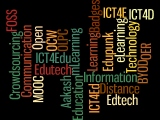You are invited to submit a proposal for a presentation, open session or poster at the…
2nd Annual mEducation Alliance
International Symposium:
2012- Partnering for Scale & Impact
September 5-7, 2012
Washington, DC.
 For this year’s mEducation Alliance International Symposium, we want to highlight your experiences and insights on partnership. What does a successful partnership mean for your work? What are the challenges and opportunities evident in partnerships designed to improve learning outcomes through the use of mobile technologies? What kinds of additional or expanded partnerships could your work benefit from, and what could the mEducation Alliance do to support this?
For this year’s mEducation Alliance International Symposium, we want to highlight your experiences and insights on partnership. What does a successful partnership mean for your work? What are the challenges and opportunities evident in partnerships designed to improve learning outcomes through the use of mobile technologies? What kinds of additional or expanded partnerships could your work benefit from, and what could the mEducation Alliance do to support this?
Under the broad theme of partnerships, we’ll be looking for presentation and open session proposals involving the following themes:
Public and Private Sector Partnership Engagement
Mobiles for Reading
Mobiles for Inclusive Education and Assistive Technology
Mobiles for Education System Strengthening
Mobiles for Youth and Workforce Development
Mobiles for Education in Crisis and Conflict Settings
The Mobiles for Education (mEducation) Alliance is an international collaborative effort between bilateral and multilateral donors, NGOs, foundations, private sector partners, academic researchers, and implementing organizations. Our collective agenda is to explore cutting-edge intersections between mobile technologies, education and development, to reduce duplicative efforts, and promote collective knowledge-sharing. The increasing ubiquity of mobile phones and coverage and the current and possible utilization of other mobile devices, including e-Readers, tablet computers, flash memory, micro/ “pico” projectors, and audio/visual devices among other technologies, provide valuable opportunities for supporting quality education impact in developing countries.
The mEducation Alliance has formed a symposium planning committee, composed of representatives of a number of supporting organizations, which will select 10-15 presentation proposals and 20-25 poster proposals based on a rating system which takes into account: 1) topical relevance to Symposium themes, 2) leading edge research or piloting of highly promising mobile technology utilization for improving quality education impact, and 3) highly participatory and interactive format to encourage networking and partnership development. The planning committee will work with selected presenters to promote interactive presentations to maximize dialogue with the audience. The Alliance will also accept a number of Open Session proposals, which will be reviewed based on the format of proposed session and level of interaction with participants, in addition to the session topic’s relevance to the overarching goals and mission of the mEducation Alliance.
Guidelines on Presentation and Poster Session Objectives
Preferred approaches to sessions include:
– Emphasis on innovative and/or cross-sectoral approaches to partnerships, and on “yet unsolved” challenges in education and the use of mobile devices;
– Innovative, interactive formats, preferably with live demonstrations whenever possible;
– Focus on lessons learned, findings, and project and research designs that have broad applicability to the education sector;
– Highlighting outcome- and impact-level results in education in developing countries; and,
– Sharing useful tools, guidelines, and methodologies that could be immediately applied elsewhere.
Guidelines on Open Session Objectives
Preferred approaches to these informal learning opportunities include:
– Highly participatory dialogs relevant to the Symposium themes;
– Creative formats which encourage networking, partnership building, and knowledge sharing (such as a FailFaire, or other format sharing lessons learned);
– Open sessions organized around a specific focal area of interest, such as geographic regions, educational level, mobile device or languages (sessions conducted in languages other than English are welcome in this regard);
– Sessions designed to delve into reflections on cross-cutting issues and the state of the field, such as ethics, gender, evaluation, or a session looking at relevant technological developments.
Proposal Template
The following items should be covered in proposals not exceeding 2 pages (excluding CVs and examples of handouts, tools, etc.).
– Presentation, Poster or Open Session title
– Type of session (panel presentation, demo, poster, quiz show, debate, discussion, etc.)
– Short abstract of the presentation, poster or session, including 2-3 learning objectives
– Presenters and their relationships to the session content (attach CVs)
– Detailed session outline
– Examples of handouts, tools, guides to be shared with participants
– Contact person and email and phone
Session proposals should be sent by Friday, May 25, 2012, to: mobilesforeducation@gmail.com.
Important Dates
Session proposals due to mEducation Alliance
Friday, May 25, 2012
Selected presenters invited to present
On or before Friday, June 22
Presenters submit all A/V requests
On or before August 1
Final Presentations, Posters, Sessions due
On or before August 8
mEducation Alliance International Symposium
September 5 – 7
Please feel free to share this letter of invitation with relevant units within your organization or to other partners or researchers who work with mobiles in the context of education, but please note that participation will be by invitation only. There are no registration fees for the Symposium, however presenters and participants will be responsible for all travel costs associated with attendance. More information is available at www.meducationalliance.org. Please address any questions to Rebekah Levi (rlevi@jbsinternational.com) and Scott Kipp (skipp@jbsinternational.com).

























































